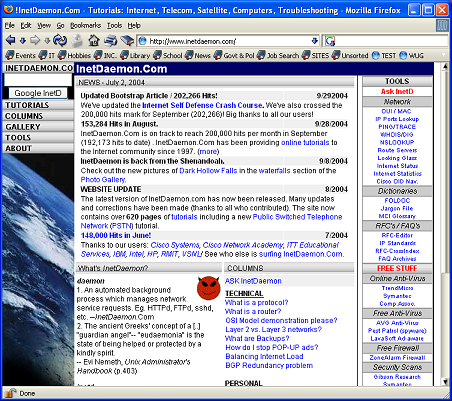- What are Web Pages?
- What is in a Web Page?
- Non-Clickable areas
- Title of the Page
- Client side scripts
- Formatted Text
- Forms
- Background images
- Clickable Areas
- Hyperlinks
- Images
- Image Maps
- Sound Files
- Video Files
- Applets written in Java
- Controls written in Active X
- Form Field
- Non-Clickable areas
- What makes Web Pages 'work'?
- How do I create a Web Page?
Definition of a Web Page
If you are reading this, you are looking at a web page. Most people who have Internet access are pretty sure they know what a web page is, but they really don't.
Web pages are electronic computer files filled with text that are stored on a remote computer called a Web Server. You can use a piece of software called a web browser to connect to that remote computer across the Internet and download the web page file to your computer. Your web browser does all the work, you just tell the browser which remote computer you want to retreive information from.
When you download a web page and display it in your browser, it looks something like this:

Usually web pages are not just one file but several files stored on the web server that your computer downloads simultaneously, organizes and displays them all in a special way defined by the special language stored within the web page called HTML.
What is in a Web Page?
Nearly all web pages have text you can read like this page does.
Some web pages have pictures:
![]()
Most web pages have hyperlinks to other pages.
Some web pages have sounds in them. Some web pages use scripts that change the content of the page or respond to the user's actions. Some web pages have small programs that are called 'applets'.
There are two kinds of areas on the page, clickable areas and non-clickable areas (no, that's not a technical term).
Static Areas
Static areas are the parts of the page that don't change and don't do anything when you put your mouse over them, click on them. These areas include:
- Text
- Images
Dynamic Areas
Dynamic areas are areas of a web page that you can put your mouse cursor over and click on and the web browser will do something. Dynamic areas include:
- Hyperlinks
- Images
What makes Web Pages Work?
What makes web pages work are the parts you don't see. Web pages are actually files full of text that look something like this:
<HTML>
<HEAD>
<TITLE>Sample Page</TITLE>
</HEAD>
<BODY BGCOLOR="#FFFFFF">
<H1>HEADLINE</H1>
<HR>
<P>This is an example page to show what a
web page should look like when viewing the
source code.</P>
<P>Here is an image<IMG SRC="./somefile.gif"> Here is
a link to another page: <A HREF="./otherfile.html">Other File</A></P>
</BODY>
</HTML>
Your web browser requests the web page and downloads the page, reads the tags in the page and uses the tags to format the page. As you can see the contents of the page are peppered with lots of really strange looking characters and codes. These pages also request other files such as pictures and sounds. Web pages contain hyperlinks.